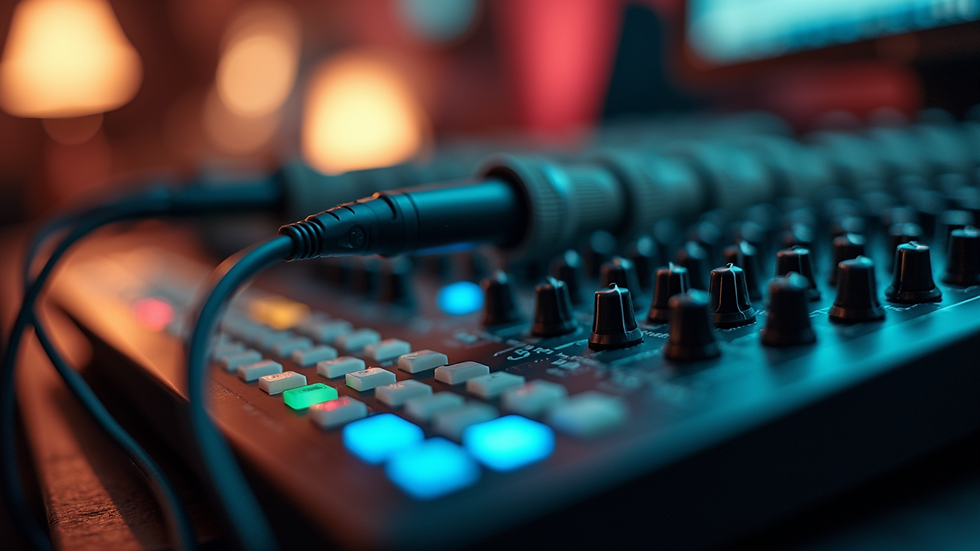Understanding the Role of a Sound Mixer
- Jamison Sweet

- Oct 13
- 4 min read
In the world of film, television, and live events, sound plays a crucial role in creating an immersive experience. Behind every clear dialogue, crisp sound effect, and balanced music track is a skilled professional known as a sound mixer. This expert ensures that all audio elements blend seamlessly to enhance the storytelling. Understanding the role of a sound mixer and their responsibilities can shed light on how much effort goes into producing high-quality sound.
What Does a Sound Mixer Do? Key Sound Mixer Responsibilities
A sound mixer is responsible for capturing, balancing, and mixing audio during production. Their work begins on set or location and continues through post-production. Here are some of the primary responsibilities that define their role:
Capturing Clean Audio: Using microphones and recording equipment, the sound mixer ensures that dialogue and ambient sounds are recorded clearly without unwanted noise.
Balancing Audio Levels: They adjust the volume of different sound sources to maintain clarity and prevent distortion.
Mixing Multiple Audio Tracks: Combining dialogue, sound effects, and music tracks to create a cohesive soundscape.
Troubleshooting Technical Issues: Quickly resolving problems with equipment or acoustics to avoid delays.
Collaborating with Directors and Editors: Working closely with the creative team to achieve the desired audio aesthetic.
These responsibilities require technical expertise, a keen ear, and the ability to work under pressure. The sound mixer’s role is vital in ensuring that the audience hears exactly what the director intends.

Sound mixing console used to balance audio levels during production
Essential Skills and Tools for a Sound Mixer
To excel in their role, sound mixers must master both technical skills and creative judgment. Here are some essential skills and tools they rely on:
Technical Knowledge: Understanding microphone types, audio signal flow, and recording formats.
Attention to Detail: Detecting subtle audio issues that could affect the final product.
Communication Skills: Coordinating with the production team to meet audio requirements.
Proficiency with Software: Using digital audio workstations (DAWs) like Pro Tools or Logic Pro for editing and mixing.
Portable Recording Equipment: Utilizing field mixers, boom microphones, and wireless systems for on-location recording.
For example, a sound mixer working on a documentary might use a shotgun microphone to capture clear dialogue outdoors while minimizing background noise. In contrast, a studio session might require multiple microphones and complex mixing software to blend instruments and vocals.

Portable field mixer used for capturing audio on location
How to be a Good Sound Recordist?
Becoming a proficient sound recordist involves more than just technical know-how. It requires practice, patience, and a proactive approach to problem-solving. Here are some actionable tips to improve your skills:
Learn the Basics Thoroughly: Study audio principles, microphone placement, and signal processing.
Practice Regularly: Record different environments to understand how sound behaves in various settings.
Invest in Quality Equipment: Reliable gear reduces technical issues and improves sound quality.
Develop Listening Skills: Train your ear to identify unwanted noise and tonal imbalances.
Stay Calm Under Pressure: Production environments can be hectic; maintaining composure helps you focus.
Network with Professionals: Join forums, attend workshops, and collaborate with experienced sound mixers.
Keep Up with Technology: Audio technology evolves rapidly; staying updated ensures you use the best tools.
By following these steps, aspiring sound recordists can build a strong foundation and grow into skilled professionals. For those interested in learning more or seeking expert services, visiting a dedicated sound recordist mixer resource can provide valuable insights and support.

Sound recordist adjusting boom microphone to capture clear dialogue
Challenges Faced by Sound Mixers and How to Overcome Them
Sound mixers often encounter various challenges that require quick thinking and adaptability. Some common issues include:
Background Noise: Unwanted sounds like traffic, wind, or crowd noise can interfere with recordings.
Equipment Malfunctions: Technical failures can disrupt the recording process.
Acoustic Problems: Poor room acoustics can cause echoes or muffled sound.
Time Constraints: Tight shooting schedules leave little room for retakes.
Communication Gaps: Misunderstandings with the production team can affect audio quality.
To overcome these challenges, sound mixers can:
Use windshields and noise gates to reduce background noise.
Regularly maintain and test equipment before shoots.
Employ acoustic treatments or choose better recording locations.
Plan ahead and communicate clearly with the team.
Stay flexible and ready to improvise solutions on the spot.
By anticipating potential problems and preparing accordingly, sound mixers can maintain high-quality audio even in difficult conditions.
The Impact of a Sound Mixer on the Final Production
The work of a sound mixer significantly influences the audience’s experience. Good sound mixing can:
Enhance Storytelling: Clear dialogue and well-balanced sound effects help convey emotions and plot details.
Create Atmosphere: Ambient sounds and music set the tone and immerse viewers in the scene.
Improve Professionalism: High-quality audio reflects well on the production’s overall quality.
Increase Accessibility: Proper mixing ensures that audio is clear for all viewers, including those with hearing impairments.
In contrast, poor sound mixing can distract the audience, cause confusion, and reduce the impact of the visual elements. Therefore, investing in skilled sound mixers is essential for any successful production.
Understanding the role and responsibilities of a sound mixer reveals the complexity behind the scenes of audio production. From capturing pristine sound to balancing multiple audio sources, their expertise shapes the way stories are heard and felt. Whether you are an aspiring sound professional or simply curious about the craft, appreciating the sound mixer’s work enriches your experience of media and entertainment.



Comments